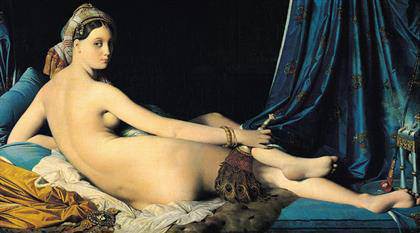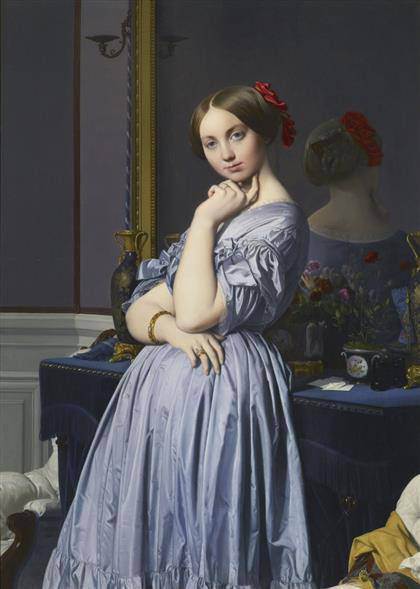
Jean Auguste Dominique Ingres
Grande Odalisque, 1814
Paris, Louvre

Jean Auguste Dominique Ingres
Comtesse d’Haussonville, 1814
New York, Frick Collection
Ingres at the Prado Museum The Museo del Prado and Fundación AXA are presenting ‘Ingres’, the first monographic exhibition in Spain on one of the most important painters in the history of art. November 24, 2015 – March 27, 2016.]]>
Source: Museo del Prado
“Ingres” offers a unique chronological survey of the artist’s career as a whole, revealing him in all his splendour. The exhibition thus opens with a seductive self-portrait that conveys his youthful energy, loaned from the Metropolitan Museum in New York, and closes with “Self-portrait of Ingres aged 78” loaned from the Gallerie degli Uffizi in Florence, a work that transmits the master’s supreme artistic authority in his final years.
The exhibition pays close attention to Ingres’ activities as a portraitist, which gave rise to one of the most beautiful chapters of 19th-century art. Perfectly capable of precisely capturing his sitters’ characters, Ingres was able to depict both the imposing presence of an Emperor in the iconic “Napoleon I on his Imperial Throne” and the dreamy nature of an artist in “François-Marius Granet” from the Musée Granet in France. All these images reveal an authentic language that arose from the artist’s ongoing dialogue with the portraits he had studied in the Musée Napoleón and the ones he later saw in Italy. The portrait of “Monsieur Bertin”, loaned from the Louvre, which is a dynamic image of the fourth estate, or that of the “Countess of Haussonville” from the Frick Collection in New York offer a superb conclusion to Ingres’ endeavours in this genre.
Displayed alongside these work is a marvellous series of sensual female nudes. “The Grande Odalisque” from the Musée du Louvre, an image of pure nudity with no narrative justification, has been one of the most influential images in the history of modern painting. “Ruggiero rescuing Angelica” depicts a sensual, voluptuous woman who is a clear paradigm of contemporary eroticism, while “The Turkish Bath” from the Louvre, a legendary work that summarises Ingres’ fascination with repetition, champions the curve as the ideal form for expressing his tireless enthusiasm with the female body, once again located in an exotic context.
This survey of Ingres’ work also includes a focus on his interest in the genre of history painting, represented by works painted in Rome in which the artist measured himself against the power of the myths of Greco-Roman literature and of Homer and Virgil, as in “Virgil reading the Aeneid” (loaned from Brussels) and the” Studies for “The Apotheosis of Homer””. This section also includes examples of Ingres’ “troubadour” paintings in which he gave free rein to his obsession with the artists of the past whom he most admired, including Raphael and Leonardo da Vinci, in works such as “Raphael and La Fornarina” (loaned from Ohio) and “François I at the Deathbed of Leonardo da Vinci” (from the Petit Palais, Paris).
Finally, the exhibition analyses Ingres’ relationship with religious painting, represented in all its variants, from small-scale intimate works such as the moving “Virgin adoring the Host” from the Louvre to monumental compositions such as “Christ among the Doctors”.
Related content
Drawings by Ingres at the Morgan Library and Museum (exhibition, 2011)
Follow us on:


